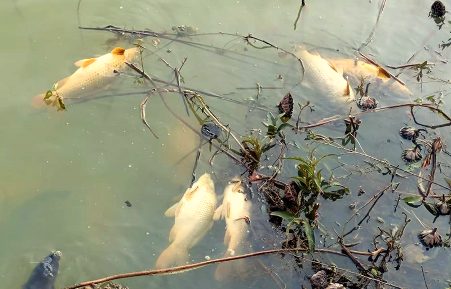A recent mass fish die-off in the historic Mansar Lake has drawn attention to the fragile interplay between human activities and natural ecosystems. This recurring tragedy, now exacerbated, underscores the urgent need for collective and sustained action by authorities, environmental experts, and the local community.
Mansar Lake, renowned for its religious and cultural significance, is a vital resource supporting diverse aquatic life and providing drinking water to nearby communities. However, the mass deaths of fish have sparked alarm over potential water contamination and the spread of waterborne diseases, posing threats to public health and ecological stability.
Investigations Highlight Causes
A study by the Fisheries Department of Sher-e-Kashmir Agricultural Science University last year identified oxygen depletion as the primary cause of fish mortality. Factors such as overpopulation of fish, excessive feeding with flour by visitors, and organic waste accumulation were cited as key contributors. Decomposing waste produces ammonia, which depletes oxygen levels, rendering the lake uninhabitable for aquatic species.
Despite efforts by the Wildlife Conservation Department to curtail household wastewater discharge into the lake, some residents continue to violate these guidelines, exacerbating water pollution and hampering conservation efforts.
Cultural Reverence and Ecological Challenges
The lake holds immense religious significance, with beliefs discouraging the removal of aquatic life. While this cultural practice has historically protected the lake’s biodiversity, it now poses challenges. Overpopulation of fish, coupled with a reluctance to intervene, has led to severe ecological imbalances. Balancing cultural beliefs with ecological preservation is both delicate and essential.
Experts and authorities stress the importance of immediate and long-term measures, including:
- Removal of Dead Fish: Clearing the lake of deceased fish to prevent further water contamination.
- Aeration Systems: Installing fountains or aerators to enhance oxygen levels, particularly during winter months when oxygen depletion is most severe.
- Fish Relocation: Controlled relocation to reduce overcrowding while respecting cultural beliefs.
- Wastewater Management: Strict enforcement of regulations against household wastewater discharge and alternative waste disposal solutions for residents.
- Awareness Campaigns: Educating locals and tourists on the harmful effects of overfeeding fish and polluting the lake, with religious leaders playing a pivotal role.
- Regular Monitoring: Conducting scientific studies and predictive modelling to anticipate and mitigate future incidents.
Preserving Mansar Lake’s Heritage
Saving Mansar Lake requires a balanced approach integrating science, tradition, and community participation. The government must allocate resources for conservation, including research funding and sustainable management practices. Partnerships with NGOs, academic institutions, and religious organisations can amplify efforts.
This environmental crisis is a stark reminder of the consequences of inaction. Mansar Lake is not merely a water body; it is a living testament to the region’s heritage and biodiversity. Swift and decisive actions are essential to preserve it for future generations, ensuring it remains a vibrant and life-sustaining ecosystem.
Call to Action
Authorities, experts, and citizens must act collectively to save Mansar Lake from further degradation. The time to act is now—before the lake’s ecological and cultural legacy is lost forever.

